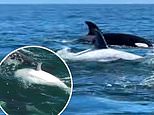- Frosty is an extremely rare four-year-old orca
- A genetic condition has caused its completely white coloration.
- Video of the sighting shows whale watchers gasping in amazement.
An “extremely rare” orca calf named “Frosty” for its milky, all-white skin has been spotted in a pod off the California coast.
Frosty has a rare genetic condition that means his black spots are much lighter than those of other orcas, giving him his distinctive white appearance.
The four-year-old whale was spotted Monday off the coast of Newport Beach in California.
It is unclear whether Frosty is male or female, but he was last seen a year ago, and the captain of the observation cruise, Dani Fasser, he told fox He was “very lucky” to locate the capsule.
He said: “We were watching a couple of giant fin whales and suddenly she (a passenger) saw puffs in the distance, which were definitely not a dolphin.”
Video of the encounter shows passengers gasping in “amazement” as the whales swim and frolic around the ship.
First of all. Two large adults with standard coloration appear, blowing puffs of air and circling in the water.
Then under water. A distinctive white back appears, which flips over to reveal Frosty’s unique all-white back and sides.
It is not known exactly what condition causes Frosty’s unusual coloring, but it is possibly thought to be leucism or a syndrome called Chediak-Higashi.
Jessica Roam, education and communications manager for Newport Landing and Davey’s Locker Whale Watching, told Fox29: “Our whale watching boat, the Catallac, was the first to spot the famous pod of orcas about nine miles off the coast of Newport Beach this morning during one of our morning whale watching cruises.
“Orca sightings are few and far between along the Southern California coast, so it was a very special encounter.”
Frosty’s pack has been seen as far north as British Columbia.
Its last sighting was in Morro Bay, California, in October 2022.
Orcas are very social animals and will remain with their mothers in the same pod throughout their lives.
They establish complex social hierarchies within each group, led by female group members.
Packs usually have two to 15 members, but larger groups sometimes gather to hunt or mate.


